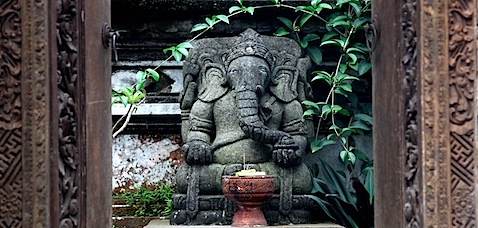1.
Ubud is a beguiling place. When you arrive - even in the dark of night - you can't help but be charmed by the place. The streets are lined with shrines and standards; every house has a carved stone entrance and tropical flowers blossom astride ubiquitous offerings to the gods.



As you drive the streets (or if you are sane, your driver drives) looking for your guest house, you snatch glimpses of massive temples. And then finally you turn down what looks to be a dreary alley and suddenly you're in the comfort and pleasure of a Balinese hotel.
But this blog post will not be hagiography as Ubud is not without its warts. The place has some of the worst traffic on earth, the most aggressive touts and, in July/August is packed with obnoxious southern Europeans (Italy-I'm looking at you!). Plus the side streets are thronged with semi-feral dogs that seem to have been trained to bark vociferously at tall white males.
2.
Everyone who visits Ubud has to go see the numerous temples that dot the town. The craftsmanship in the stone carvings and the doors is incredible.
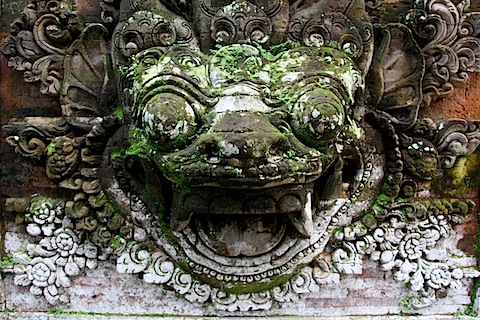





3.
From the moment you arrive, Ubud is obviously a charming place, but it's also a bit of a trickster. For the more you explore, the more you realize that its real charms are hidden and won't be given up so easily.
For example, you're walking down the main street. You come to a set of stairs that lead down to a small stream. You walk down the stairs and find that it's a canyon where two streams come together.
Overhead a rickety concrete bridge (I didn't think you could say that until I saw this one) links a cafe that has been terraced into the hill and the street. It crosses one of the streams, which also runs through a thicket of morning glories that are cascading down from the trees above.
As you walk along the banks of the stream, you come to a temple that can only be accessed by wading across the stream.
Later, while sipping a delicious ginger tea (just ginger root in hot water) at the previously mentioned terraced restaurant, you'll watch an old lady place offerings in the temple.

4.
The gender roles in Bali seem to have some hard and fast rules. Any carpentry/construction will be done by men. Any manual labour will be done by women (you see them shoveling or carrying firewood on their head all the time. We even saw one carrying steaming corn).
If something is to be sold and it's a perishable or dry good, it will be by a woman. If it's transportation, it will be a man.
And when it comes to smoking, that's for the men only. In fact, we were on a plantation tour and one of the offerings being placed had a cigarette in it. I asked about it and the (male) guide remarked "we treat our gods like men!"

5.
Another charming scene:
You're standing on the bridge in Ubud. You notice that down below you there appears to be a temple in the jungle next to the river.
You walk back and try to find a path down. The first route is a dead end, taking you directly to the river's edge, but it suggests another route.
You successfully find the temple but then notice that there's a path alongside it.

It turns out that the temple is built at the junction of two streams and the path climbs the ridge behind it. Soon you're walking amongst grass and palms and gazing down the jungle on either side of you.

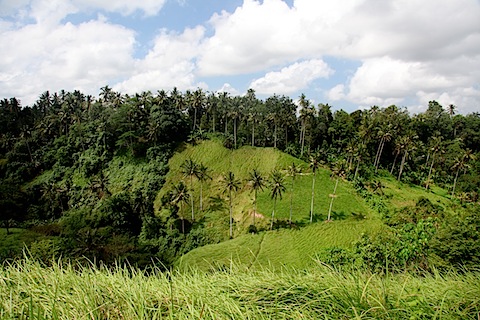
You keep climbing and the landscape finally opens up into a series of rice paddy terraces. This being Ubud, there's a restaurant where you can grab a drink and sit next to paddies to enjoy the view . (This being Ubud there are also countless art galleries nestled amongst the rice paddies).
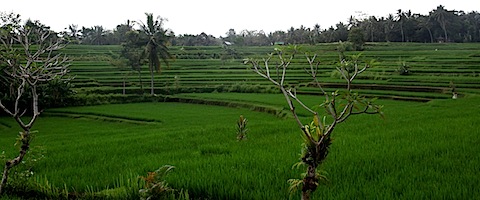
6.
In fact, sometimes it feels like all of Bali is just a giant irrigation project.
If you look at a map of central Bali, you will see a lot of water:
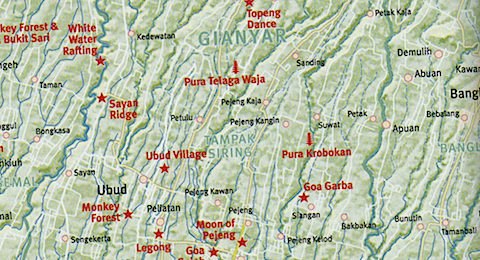
And as you walk around the towns, you'll turn a corner or pass a house and suddenly find that you've been walking over a stream without realizing it:

When you're in a town you can wonder about why there's so much irrigation, but it become obvious when you hit the countryside and see all the rice that's been planted:
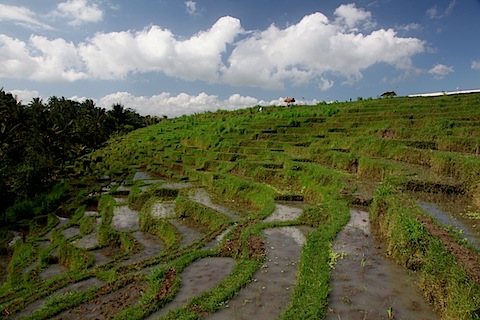

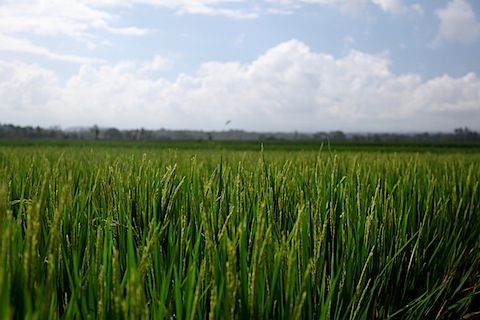
This island is the perfect place to grow rice and the locals have built a complex network of dams, canals and waterways to do so (perhaps that's why the Dutch wanted them as a colony).
7.
We took a tour of a coffee plantation to see how all the local drinks are made. Other than tourism, Bali's economy is based on exporting coffee, cloves and a few other spices.

At the place we visited, they roast small batches of coffee by hand:

We also learned the difference between the male (top photo) and female coffee beans. Every bean has to be sorted and then the stronger-tasting male beans are blended with the female to flavour the coffee:

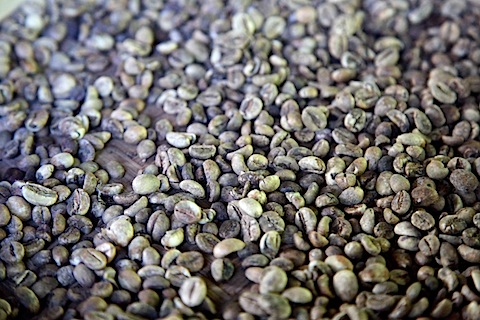
This place also happened to make Lewak coffee. That's a much pleasanter way of saying "coffee made from the dung of civets who ate coffee beans:"
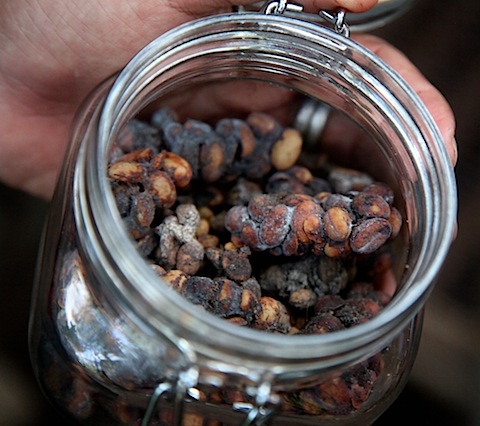
Entertainingly, the guy who runs the place used to throw away any civet dung that they found. Then one day he was watching the Discovery channel and saw a program saying that civets only eat the best beans and an enzyme in their stomach flavours the coffee uniquely. Now they process the dung and sell it at premium prices.
You can't make this ~~shit~~ stuff up.

8.
Ladies and gentlemen, I give to you the drullet. Or maybe the mullock if you prefer. Basically, this guy had the silliest haircut I'd ever seen: bangs on the front, dreadlocks at the rear of his mullet, so I had to snap a photo.

Now before you start saying that I'm mean, let me admit that I have bad hair and it takes one to know one. Or perhaps, I should say that I had bad hair.
I didn't shave for a while and then turned it into a dodgy stache just to bug Wen. This worked, but she promised never to kiss me until I shaved it; it was gone the next day:
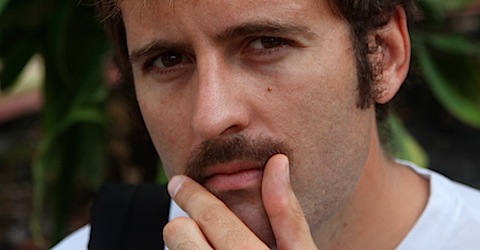
Since then, I've gotten a haircut as well (always a unique experience in a country where you don't speak the language), so take a minute to appreciate the above photo and what could have been.
9.
Bali is one of the most colourful places you'll ever visit - and I mean the flowers, not the language:



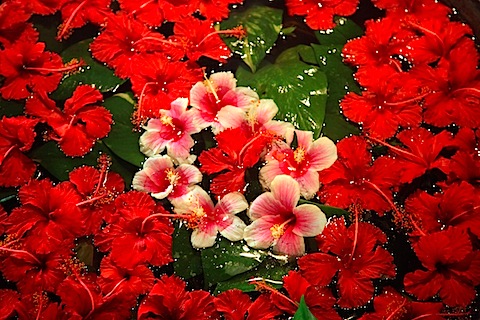
10.
Hello! Hey sir, you need taxi? How about tomorrow? Maybe just look? Good price for you! You like sarong/t-shirt/carving/massage/\<insert good or service here>?
Bali has a couple of issues. First, there's no free land; that was exhausted years ago.
Second, there are too many people. The average couple has four children; the government is trying to get that down to two but finding it hard going.
Combine this with a society that has a complex culture (architecture, food, ornamentation, clothing, etc.) but no technology (other than irrigation ditches, everything's imported here) and you've got an employment situation.
There's no free land and the existing plots can't be split much smaller. There are no manufacturing jobs so you've got to work in the tourism industry.
And the barriers to entry there are pretty low. After all, taxis/massages/crappy t-shirts are basically fungible: one is the same as the other. As a result, everyone tries to get to you at the moment you might make a purchase decision so that you won't accidentally go elsewhere.
Hence touts are everywhere.
You walk down the streets of Ubud and ever thirty feet someone asks you if you want a taxi. Some bastard taught the locals that if you don't get it now, ask the person if they want the taxi tomorrow instead. One guy even had this on a sign: one side said "taxi?" and when you said no he flipped it over to reveal "maybe tomorrow?"
In Lovina Beach we had guys bicycle up to us and ask us if we needed taxi service. Throngs of women offered us massages on the beach - even though they could see that we had turned down their compatriots - and insisted that "we come to them" if we needed one.
At first it's kind of funny but ultimately it's sad. If you're Balinese, a lot of your life is going to be spent alternating between pitching services nobody wants and waiting around for someone to pick your service. Such are the limitations of a tourism-based economy.
11.
There's actually one manufacturing industry in Bali: textiles. It's a cottage industry making sarongs and custom suits for tourists and locals alike. However, it really is just a cottage industry - take a look at the sewing machine used by one of these places.

I literally think my grandmother may have used that machine. And I saw these everywhere I went; they were in all the different seamstresses' shops.
12.
Driving in Bali is an interesting proposition. The island, which is only 150 km long, has a population of over one million and not a single highway. The streets are clogged with diesel trucks and buses battling with an army of scooters.
Since the island is basically a ridge of volcanoes, a straight rode is a rarity. Your driver (and again, I highly suggest that you leave the driving to someone else) will demonstrate his manhood by bravely overtaking all traffic.
The unspoken rules of the rode state that a bus or car has right of way over oncoming scooters, so he will not hesitate to face them down in a game of chicken. Sometimes he may even play chicken with an oncoming bus. This game is substantially less fun.
At times you'll approach a three or more way crossing that is not marked. If the gods are willing, you will not stop. If they are less happy, you may find yourself cut off by scooters. Just close your eyes.
If you're particularly lucky, as we were, your driver will also serenade you with music. Our driver chose to forsake traditional Balinese folk music for European techno. Between the techno, coffee and cigarettes, we got to our destination in what must have been record time.
13.
Sunset at Pura Tanah Lot is a bit of a cliche that every tourist must do. And, since you're a tourist, make sure you do it. It's spectacular.

14.
If you're looking for a good meal or food experience, I suggest the following:
- Ubud: grab a coffee at Tutmak
- Ubud: try the chicken curry at Murni's Warung down by the river. Sit on the balcony with a 60 foot drop to the river below; the jungle sits across from you
- Ubud: have dinner and watch a show in the temple next to the lotus pond of Cafe Lotus. Remember, you're a tourist and are allowed to do this without shame. Spend the extra $10/person to sit at an outdoor table. Revel at the Balinese's mastery of the xylophone
- Lovina: try the coconut and lemongrass ice cream at Jasmine Kitchen. They claim it's world famous and, if not, it should be
- Lovina: have breakfast at Akar. The croissants and coffee are great; sit in the back next to the pond
- Lovina: walk down the beach at night until you find a place that will make you dinner on the beach. If you eat early you can catch the tail end of the sunset. And remember you're there for the experience, not the food
15.
Bali is a combination of Hindu and Buddhist. Unfortunately, this means that they consider the swastika to be a sacred symbol. It is everywhere, but please don't think it's for a certain type of tourist...
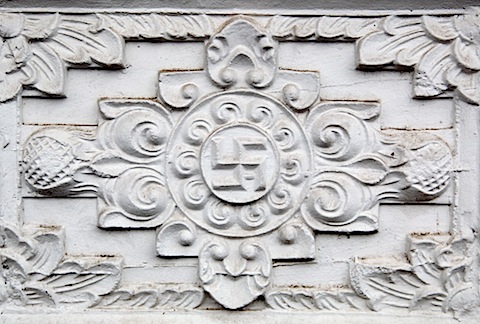


16.
Indonesia's currency is the Rupiah. It has been devalued massively over the years, to the point that everyone seems to carry a calculator around because there are three unnecessary zeroes at the end of every note.
in fact, inflation has been so bad, that the government has had to reduce the value of the metals in their coinage. Here's a shot of the old and new 500 Rupiah (between $0.05 and $0.06 depending on the prevailing exchange) coins:
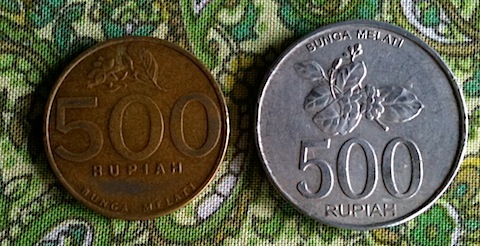

What you can't tell from the photo is that the newer coin is taped to the table as it's lighter than air and would otherwise float off.
17.
This island is a special place. Come visit, just not during August.



